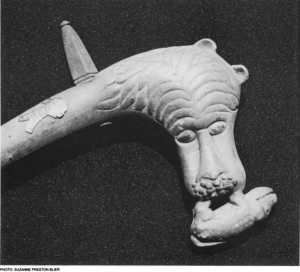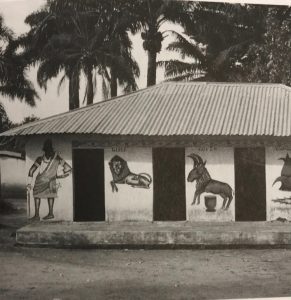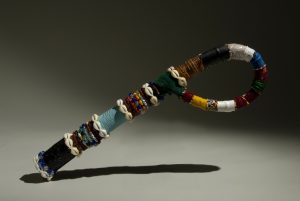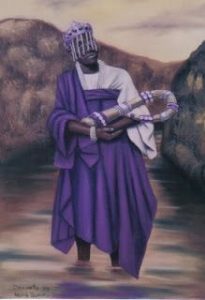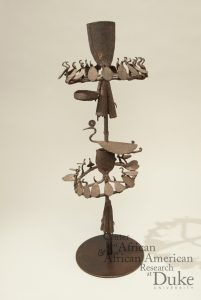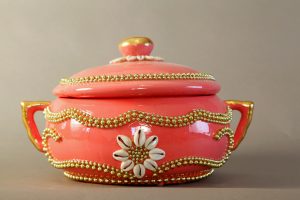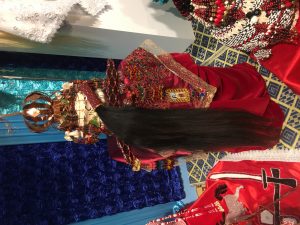On September 26, I walked into the Spirited Things Exhibition at the Fleming Museum for an exclusive look at the unfinished exhibit. Greeting the class at the doorway was eshu-elegbara, an Orisa who specializes in spiritual communication. As the class was set free to roam, I moved past Eshu where a flash of tiger print caught my eye. Looking at the object, front to back, I realized it was an outfit composed of a maroon shawl and a synthetic tiger print skirt. The shawl, which was separate strips of cloth woven together and decorated with cowry shells, had a shirt underneath which was also riddled with hundreds of cowry shells. There were so many shells stitched into the outfit that the wearer would likely experience a small party with each step, hundreds of jingling shells clacking together. As I looked closer at the outfit I noticed the mannequin had intricately woven braids as well. After this observation, I realized I had yet to look at the actual title of the artifact, it read “Attire of the Manifest God Ṣango.” This outfit is worn by those who been spiritually possessed by the Yoruba god Ṣango. I noticed in the reading that all devotees wear this outfit, and I wondered how this outfit contributed to spirit possession among those individuals. With this I began to investigate why the outfit worn by a bride was essential for spirit possession. In this essay I will provide background on Yoruba cultures and customs, and then explain how this outfit contributes to spirit possession.
Ṣango is the Yoruba god of thunder, who yields his Thunder Axe, Oshe, and now represents the powers of the Oyo kings. Glazier, author of “If Old Heads Could Talk” writes, ”Sango is the most powerful and the most feared Yoruba deity both in Africa and in the Diaspora.” It is in his reputation that one can can really understand his power. Like previously mentioned, Ṣango takes many brides, as he manifests his soul in the body of his devotees. Miles Richardson, author of “Beyond Conversion and Syncretism” illustrates that wives of Sango constantly bring about the áse and presence of the Orisa. This honors the god and creates an incentive for him to bless and protect those who worship him. However, hundreds of other Orisa are worshiped by Yoruba culture, particularly through the use of altars and different altar objects. These objects are set in a particular spacial arrangement which generates áse, the primordial life force residing within all beings.
Áse is essential to all Yoruba worship. It is áse that charges objects on an altar, giving them energy and turning them into more than just pieces of material. After objects are used in particular ways, áse can be generated and used to call spirits before those who have summoned them. Just as important as áse, are the physical objects on the altar which is being worshiped. Particular items can symbolize a broad range of different things, summoning and worshipping particular Orisa. Each object can be a particular offering to Orisa, for instance money or liquors are offerings which bring about áse and strive to enrich and nourish that Orisa.
Those who worship Sango specifically undergo spirit possession, where the soul or energy of a particular Orisa enters your body. Sango possession is a particular form of spirit possession where the bride can be either male or female. The term bride is gender inclusive of those devoted to Sango. Spirit possession in general has been typical of Yoruba culture since its origin and is a means of communication with the dead. It is in the crossover to a parallel reality where those undergoing possession can find solutions to problems, see future events, and communicate with their departed ancestors. It is a process that is deeply important, yet deeply hard to understand. In Yoruba culture they do not have the same notion that death means that person is completely gone, but spiritually transferred to a different world. It is through this world Yoruba people connect to the departed, keeping in touch with them, hopeful to return to their presence someday.
With this being said, the outfit worn by a bride of Sango must help link a devotee to the spirit of Sango himself. Previously stated, Yoruba culture primarily uses altars with many objects to bring about áse, which can summon different Orisa. However, in this worship there is no apparent altar. It was at this point in my research where I looked to a reading by Thompson where he states the altar of River goddess, Oṣun, is not a tangible altar, but instead the holy river she once touched. From this I could conclude that the body of a Sango devotee serves as the altar which calls to Sango. An altar does not have to be a physical structure, but anything decorated with objects to worship an Orisa.
If the body of a mount serves as the altar which worships Sango, then the outfit which they wear must consist of various artifacts which can summon the spirit of Sango. Glazier writes, “Sango devotees belief that illness and misfortune result from a lack of attention to the Orisa, and a belief that when properly attended to, will help them in their daily lives.” This serves as evidence to support why brides wear this outfit in relation to Sango. By wearing the outfit, brides are decorating their altars with power objects which bring about áse, summoning Sango to possess those who worship. From here, Sango can help them in their struggles. In the same article by Glazier, he states that devotees attempt to establish binding contracts with Sango by wearing this outfit, however Orisa are fluid and characterized by a large degree of uncertainty. It is by wearing this outfit brides try to solidify their commitment to Sango, constantly worshiping him throughout the day.
Each article of clothing represents something different, much like how individual altar objects represent different symbols as well. The synthetic tiger pelt worn by devotees represent Sango’s ferocity and power. The tiger is a jungle cat with a high social status on the food chain, Sango is similar to this in a lot of ways. He is a highly respected god, and resides high up in the Orisa hierarchy and shares the ferocity of a wild tiger. This pelt is used to symbolize those qualities on the altar, paying tribute to Sango’s strength.
Equally as important is the cowry covered shirt and shawl. First off, cowries were a form of West African currency. With this being said, the cowries are meant to enrich Sango with offerings of money. Also, the noise in which the shells make generate áse by the jingling they make. Often noise, particularly drums, are used in Yoruba ritual to bring about áse and coerce spirits to visit alters. The cowries can function as their own device, generating noise and drawing áse into the alter through movement and dance.
The braids worn by Sango brides are also an important object within the altar. The braids which mounts of Sango wear in their hair symbolizes their marriage to Sango. This style is called agogo and is taken very seriously, as different braiding patterns all symbolize different things. In Justine M. Cordwell’s “The Fabric of Culture,” he states “Devotees of Sango don’t shave their head after initiation…head shaving upon death marks passage from life and membership, to death and nonmembership.” This specific pattern of braiding is thus an altar object which broadcasts ones devotion to Sango and his worship.
By devotees wearing this particular outfit, they can create an altar on their bodies which invites Sango to possess them. The different elements of the costume embody Sango and draw áse to the body, inviting Sango to reside within his altar, the mount. By wearing the outfit the mount creates a particular spacial arrangement of objects, noises, and practices which act as any regular altar to draw Sango from the spirit world into the vesicle of the human body. With this being said, the outfit worn by a bride of Sango is meant to activate the presence of áse and call forth Sango to the human altar. The outfit is crucial in the physical spirit possession of a mount as it is the source of áse, the power which drives the ritual to success. From the hundreds of cowries, to the furious tiger pelt, each piece of the outfit serves as an altar symbol, an effort to communicate with Sango, the mighty god of thunder.
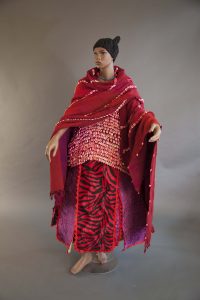
Bibliography of sources which research spirit possession among African Diaspora religions.
Cordwell, Justin M. The Fabric of Culture. Paris: Mouton Publishersn.d
I found this word using the library database, with keywords “Outfit of Sango’s Bride.” This source directly examines the clothing worn by different African cultures through an ethnographic lens. The portion I focused on was clothing worn by Sango devotees. This source illustrates the symbols behind the clothing worn by brides, in particular their styles of hair braiding.
This source is written by Corwell, in collaboration with other anthropologists. With this being said, the perspective is unbiased and aims to describe the different garments worn by different cultures.
Matory, J. L. Rival Empires: Islam and the Religions of Spirit Possession among the Ọ̀yọ́- Yorùbá. N.p.: Wiley on behalf of the American Anthropological Association, 1994.
I found this source using the keyword spirit possession within the Bailey Howe Library research database. This source directly examines spirit possession among Yoruba people, with a specific focus on possession among women. This source outlines motives behind possession, and how this helps to shape character and identity.
The source is written by Matory, an accomplished anthropologist. Matory writes strictly research based books where most of the information is from credible sources or first hand experience. With this being said, the information published is not biased it is ethnographic research aimed to published research regarding spirit possession within a broader religion.
Matory, J. L. Sex and the empire that is no more : gender and the politics of metaphor in Oyo Yoruba religion. Minneapolis: University of Minnesota Press, 1994.
This sources was recommended to me by Doctor Vicki Brennan, a professor at the University of Vermont. In this source Matory makes a case for the existence of “meta-tropes” of gender in Yoruba spirit possession, illustrating these practices are deeply embedded in Oyo politics. Matory explains possession within the social and political context of local government, as in the case of traditional Songo and Yemoja possession in Oyo Yoruba religion. While doing this Matory broadcasts a community’s negotiation of personal power and the metaphors of gender among priests and priestesses.
Matory Writes from a non biased view point, providing factual information with wise anecdotes and metaphors to help understand difficult ideas which are foreign to our culture. Matory writes and researches with the intention of understanding, therefore the information published is accurate not only factually, but to the culture being researched as well.
Richardson, Miles. Beyond Conversion and Syncretism: Indigenous Encounters with Missionary Christianity. N.p.: Berghahn Books, 2011.
Richardson’s book contained a lot of solid information regarding Sango Spirit possession. Richardson illustrates the role devotees play in spreading the áse of Sango. He writes about how being a devotee is a constant practice which takes avid worship. It is through this worship Richardson states Sango rewards his followers.
Richardson writes ethnographically, illustrating the mindset of the Yoruba people who worship Sango. His writing is unbiased and informative. The contents, specifically on pages 146-156, were useful in understanding how áse played a role in possession.
Thompson, Robert F. Face of The Gods. New York City: The Museum of African Arts, 1993.
I originally discovered this source from reading it for a homework assignment. This particular Thompson article illustrates the altar of Osun, making a point to say that the altar is not physically constructed, but instead a naturally occurring river. This helped my research because it enabled me to make the connection between the body being used as an altar in ritual despite not being a typical altar.
Thompson writes from a colorful, non biased perspective. He tells a story with his research rather than regurgitating facts. These stories are unbiased and factual and written for general audiences. With this being said, Thompson writes well, but clearly and concisely.
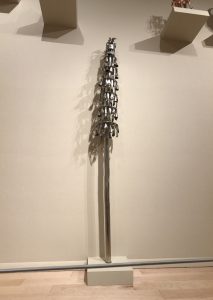
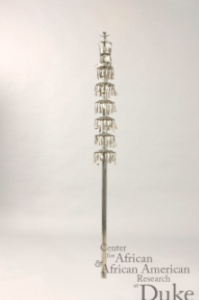
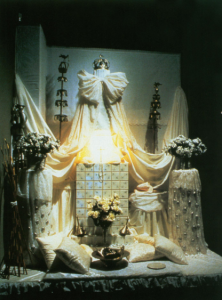
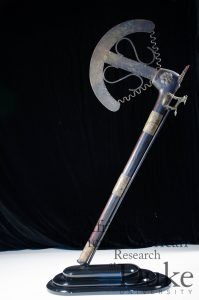 The object was stuck in a falling state, suspended in mid air. A weapon among an altar, a scepter with crowns surrounding. I wanted to know where there was such a violent looking object in a place where everything else is full of color and life. The scepter does not stand out. It has little color and small designs that are worn away. The handle is simple, wooden staff. The kind of wood that if you held it, it would give you splinters. There are three brass segments on staff and right above the one at the top there is a cat like creature. It is a very interesting creature with a big cat body and long ears or horns. One of the biggest reasons why I picked this object is this animal and the shadow it casts. The shadow from the display makes it look like the cat is walking along the staff. Right before the axe head, two horns protrude, similar to the cat’s ears . There is the blade that is made of metal with tidal waves throughout the edge. Two metal pieces hold down the blade, an S shape metal piece and a spring piece. The last thing on the scepter is a flower a 6 petal flower below the horns and next to the head. On every other petal there are bumps that seem to make a simple pattern. This lead me to what I wanted to learn from this object. Why is this deadly object in a place of worship. Even within the scepter there are juxtapositions as there is a flower that draws your eye to it. I wanted to learn everything about this scepter and the god it represented, Hevioso or shungo. Contrary to its looks, it is not a weapon, it a tool used for religious and political festivals. I question the meaning behind with the aspects of the king and the deity he represented. As a hot god, Hevioso in vodou or Shungo in yoruba tradition, he does things quickly and people who have him as a deity are usually in power. This leads me to argue that this scepter was used to show power over the king’s followers. In the rest of the paper, I will give background on Hevioso and how a different king follows him and basic information on vodou and Yoruba tradition. Next I will talk about a king who was represented by the same god, Hevioso, King Glele and will then show how the scepter would be used in a festival based on first hand basis of people who research the religion. I will explain the cat creature on top of the staff and the significance it has towards the scepter.
The object was stuck in a falling state, suspended in mid air. A weapon among an altar, a scepter with crowns surrounding. I wanted to know where there was such a violent looking object in a place where everything else is full of color and life. The scepter does not stand out. It has little color and small designs that are worn away. The handle is simple, wooden staff. The kind of wood that if you held it, it would give you splinters. There are three brass segments on staff and right above the one at the top there is a cat like creature. It is a very interesting creature with a big cat body and long ears or horns. One of the biggest reasons why I picked this object is this animal and the shadow it casts. The shadow from the display makes it look like the cat is walking along the staff. Right before the axe head, two horns protrude, similar to the cat’s ears . There is the blade that is made of metal with tidal waves throughout the edge. Two metal pieces hold down the blade, an S shape metal piece and a spring piece. The last thing on the scepter is a flower a 6 petal flower below the horns and next to the head. On every other petal there are bumps that seem to make a simple pattern. This lead me to what I wanted to learn from this object. Why is this deadly object in a place of worship. Even within the scepter there are juxtapositions as there is a flower that draws your eye to it. I wanted to learn everything about this scepter and the god it represented, Hevioso or shungo. Contrary to its looks, it is not a weapon, it a tool used for religious and political festivals. I question the meaning behind with the aspects of the king and the deity he represented. As a hot god, Hevioso in vodou or Shungo in yoruba tradition, he does things quickly and people who have him as a deity are usually in power. This leads me to argue that this scepter was used to show power over the king’s followers. In the rest of the paper, I will give background on Hevioso and how a different king follows him and basic information on vodou and Yoruba tradition. Next I will talk about a king who was represented by the same god, Hevioso, King Glele and will then show how the scepter would be used in a festival based on first hand basis of people who research the religion. I will explain the cat creature on top of the staff and the significance it has towards the scepter. 